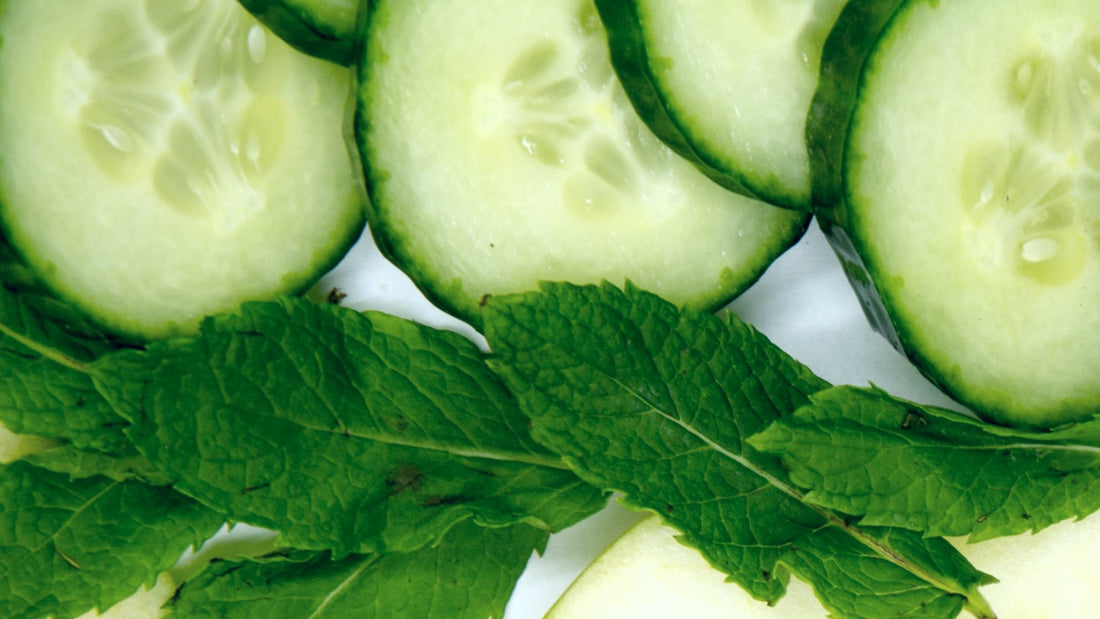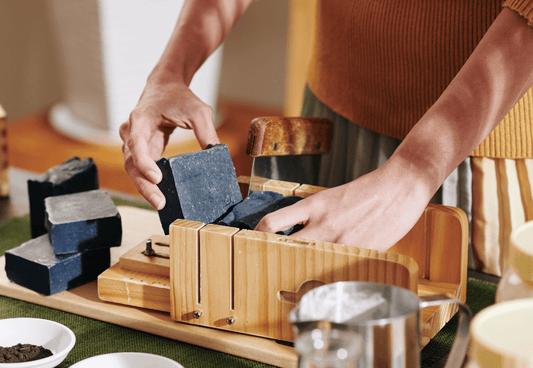We've been feeling the heat recently at The Soapery HQ and have been longing for a cooling shower at the end of the day. We've found a way to make that shower even more refreshing - by using our fresh and zingy cucumber & mint soap recipe!
The beautiful natural cocoa butter, olive oil and coconut oil work together to keep your summer skin hydrated and the combination of the essential oils not only smell fantastic but also refresh body and mind.
If you're a beginner, we recommend you skip the optional swirling steps. But if you're ready to try your first swirl, give it a go!
Our cucumber & mint soap recipe is easy to make, just follow the steps below...
What is cucumber seed oil?
Cucumbers seem watery not oily, don't they?! So how do we get a lovely oil from cucumbers?
The cucumber seeds are cleaned and dried before being cold pressed, this releases their natural oil and voila - we have cucumber seed oil! And yes, it surprised us too when we first heard of it!
It is yellow in colour and has a fresh, earthy aroma, much like cucumbers do themselves.

Why add cucumber seed oil to soap?
Cucumber seed oil contains great levels of omegas and fatty acids which our skin just loves. These are great for hydrating and protecting your skin so people with dry skin will really like this recipe.
The oil is also very gentle so it is great for sensitive skin and has a comedogenic rating of 1 which means it is very unlikely to block your pores.
Why add essential oils?
Firstly of course - they smell fantastic! But more importantly they also bring their own special properties to the soap.
Peppermint essential oil will give the soap a tingly cooling sensation on your skin which is just lovely in hot weather. It is also known for soothing aching muscles and could help reduce itching which is handy if you've got any summer bug bites.
Lemongrass essential oil has been used for its antibacterial and antifungal effects, both of which are never bad things to have in a soap, plus it has also been used to relieve stress which is a property we love in anything!
The zingyness of lemon essential oil can give you a little mood boost and help you feel uplifted, plus it also can have antibacterial effects.
Let's have a go at our cucumber & mint soap recipe...
Makes 9-10 bars of soap
Takes 1 hour making time and 4-6 weeks curing time
This recipe uses a 5% superfat to make your cucumber & mint soap wonderfully moisturising
Equipment:
To make our cucumber soap recipe, you will need:
- Gloves
- Goggles
- Digital scales
- Digital thermometer
- Stick blender
- Silicone soap mould or DIY alternative
- Silicone spatula
- Heatproof bowl
- Plastic measuring jugs, ideally 2x 1L and 1x 2L
- Chopstick or stainless steel spoon and a toothpick for swirling
Ingredients:
- Olive oil pomace 240g | 263ml
- Cocoa butter 240g
- Coconut oil 240g
- Cucumber seed oil 80g | 87ml
- Water 240g
- Sodium hydroxide 114g
- Peppermint essential oil 6g | 7ml
- Lemongrass essential oil 6g | 7ml
- Lemon essential oil 12g | 15ml
- Emerald green mica powder 3g
Method:

1. Mix the sodium hydroxide solution
- Put your gloves and goggles on.
- Open the window, the fumes are unpleasant.
- Weigh the sodium hydroxide
- Weigh the water
- Add the sodium hydroxide to the water, not the other way around
- Mix well until combined. Careful, it will get hot!
- Leave to cool

2. Weigh and heat the oils
- Weigh the olive oil, cocoa butter, cucumber oil and coconut oil into a heatproof bowl.
- Heat gently above a pan of boiling water, or using short bursts in the microwave.
- Stir regularly until completely melted.
- Once melted, leave to cool.
- In a separate jug weigh each essential oil.
- Weigh the green mica powder in a separate container.

3. Test the temperatures
- Test the temperature of the sodium hydroxide solution. It should be between 25C and 40C.
- Leave it to cool if necessary, but don't reheat it if it's too cool.
- Test the temperature of the melted oils. They should be between 35C and 40C.
- Leave it to cool or reheat if necessary.
- Once the temperatures are correct, add the sodium hydroxide solution to the oil mixture.

4. Blend until trace
- If you're creating a swirl, make sure you stop blending at a very light trace. The picture above shows a light trace.
- Mix with the stick blender, and blend with short pulses.
- Watch for the soap batter starting to thicken.
- Test for trace by dripping soap batter on the surface of the mixture. If the drips sit on the surface before disappearing, your mixture has reached trace.
- Stop blending once your soap mixture has reached a light trace.
- Add the essential oil blend.
- If you don't want to create a swirl pattern in your soap, you can add all of your mica powder in to your soap batter now. If you do want a swirl, don't add it yet!
- Mix and blend a little until combined.

5. Prepare to swirl (optional)
- If you don't want to swirl your cucumber soap, move on to step 7.
- Separate roughly a third of your soap batter into another jug.
- Mix this with the green mica powder.
- Pour the uncoloured soap batter into your mould.
- Tap on the work surface to get rid of air bubbles
- Pour the green soap batter in from high above the mould, this helps the green swirl penetrate the soap.

6. Create the swirl pattern (optional)
- Place the thick end of the chopstick, or spoon handle, into the soap mould at one end.
- Push it all the way to the bottom of your soap mixture.
- Move in a spiral pattern towards the opposite end of the soap mould, like the picture above.
- For a secondary swirl, use the thin end of the chopstick, or a toothpick, to create random swirl patterns on the top surface of the soap.
- If you're doing a secondary swirl, don't put the chopstick in too deep as it will mess with the first swirl

7. Leave to cure
- Unmould your soap
- Place bars with space in between
- Leave to cure for 4-6 weeks.
Continue Reading:
Now you've learned how to make homemade cucumber soap, why not continue reading?
- Love cold process soap but not a fan of the citrus and mint combo here? Why not try our beautiful Rose Soap Recipe
- Been wondering if peppermint oil can help with hair loss? We've taken a deep dive and looked at the science in our blog Peppermint Oil For Hair Loss
- Looking for another summer soap recipe? Try our Hot Process Coconut Milk Soap Recipe
Did you try our cucumber soap recipe? Let us know in the comments below!




2 comments
Hi Cheryl,
Thanks a lot for your feedback! It’s great to hear that you find our newsletters have been helpful and informative!
I have been getting your newsletter for a number of years now and I really should have complimented you well before now! They’re really inspiring and a wealth of information and ideas!! The way the newsletter links directly to the recipes and products is also..genius! Thankyou for another great recipe!